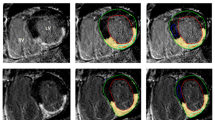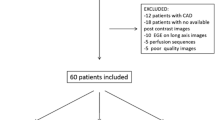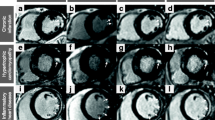Abstract
The purpose of this study was to compare different semi-automated late gadolinium enhancement (LGE) quantification techniques using gadobutrol and gadopentetate dimeglumine contrast agents with regard to the diagnosis of fibrotic myocardium in patients with hypertrophic cardiomyopathy (HCM). Thirty patients with HCM underwent two cardiac MRI protocols with use of gadobutrol and gadopentetate dimeglumine. Contrast-to-noise ratio (CNR) between LGE area and remote myocardium (CNRremote), between LGE area and left ventricular blood pool (CNRpool), and signal-to-noise ratio (SNR) in LGE were compared. The presence and quantity of LGE were determined by visual assessment. With signal threshold versus reference mean (STRM) based thresholds of 2 SD, 5 SD, and 6 SD above the mean signal intensity (SI) of reference myocardium, the full-width at half-maximum (FWHM) technique was used. The volume and segments of the LGE area were compared between the two types of contrast agents. LGE was present in 26 of 30 (86.6%) patients in both protocols. The CNRremote of fibrotic myocardium in gadobutrol and gadopentetate dimeglumine agents was 26.82 ± 14.24 and 21.46 ± 10.59, respectively (P < 0.05). The CNRpool was significantly higher in gadobutrol (9.32 ± 7.64 vs. 6.39 ± 6.11, P < 0.05). The SNR was higher in gadobutrol (33.36 ± 14.35 vs. 27.53 ± 10.91, P < 0.05). The volume of scar size in MR images acquired with gadobutrol were significantly higher than those with gadopentetate dimeglumine (P < 0.05), and the STRM of 5 SD technique showed the greatest agreement with visual assessment (ICC = 0.99) in both examinations. There was no significant difference in fibrotic segments of the fibrotic myocardium in the LGE area (P < 0.05). This study proved that the Gadobutrol was an effective contrast agent for LGE imaging with superior delineation of fibrotic myocardium as compared to gadopentetate dimeglumine. The 5 SD technique yields the closest approximation of the extent of LGE identified by visual assessment.






Similar content being viewed by others
References
Maron BJ (2009) Sudden death in hypertrophic cardiomyopathy. J Cardiovasc Transl Res 2(4):368–380. doi:10.1007/s12265-009-9147-0
Wagner A, Mahrholdt H, Holly TA, Elliott MD, Regenfus M, Parker M et al (2003) Contrast-enhanced MRI and routine single photon emission computed tomography (SPECT) perfusion imaging for detection of subendocardial myocardial infarcts: an imaging study. Lancet 361(9355):374–379. doi:10.1016/S0140-6736(03)12389-6
Korkusuz H, Esters P, Huebner F, Bug R, Ackermann H, Vogl TJ (2010) Accuracy of cardiovascular magnetic resonance in myocarditis: comparison of MR and histological findings in an animal model. J Cardiovasc Magn Reson 12:49. doi:10.1186/1532-429X-12-49
von Knobelsdorff-Brenkenhoff F, Bublak A, El-Mahmoud S, Wassmuth R, Opitz C, Schulz-Menger J (2013) Single-centre survey of the application of cardiovascular magnetic resonance in clinical routine. Eur Heart J Cardiovasc Imaging 14(1):62–68. doi:10.1093/ehjci/jes125
Boye P, Abdel-Aty H, Zacharzowsky U, Bohl S, Schwenke C, van der Geest RJ et al (2011) Prediction of life-threatening arrhythmic events in patients with chronic myocardial infarction by contrast-enhanced CMR. JACC Cardiovasc Imaging 4(8):871–879. doi:10.1016/j.jcmg
Harrigan CJ, Peters DC, Gibson CM, Maron BJ, Manning WJ, Maron MS et al (2011) Hypertrophic cardiomyopathy: quantification of late gadolinium enhancement with contrast-enhanced cardiovascular MR imaging. Radiology 258(1):128–133. doi:10.1148/radiol.10090526
Mikami Y, Kolman L, Joncas SX, Stirrat J, Scholl D, Rajchl M et al (2014) Accuracy and reproducibility of semi-automated late gadolinium enhancement quantification techniques in patients with hypertrophic cardiomyopathy. J Cardiovasc Magn Reson 16:85. doi:10.1186/s12968-014-0085-x
Amado LC, Gerber BL, Gupta SN, Rettmann DW, Szarf G, Schock R et al (2004) Accurate and objective infarct sizing by contrast-enhanced magnetic resonance imaging in a canine myocardial infarction model. J Am Coll Cardiol 44(12):2383–2389. doi:10.1016/j.jacc.2004.09.020
Choudhury L, Mahrholdt H, Wagner A, Choi KM, Elliott MD, Klocke FJ, et al (2002) Myocardial scarring in asymptomatic or mildly symptomatic patients with hypertrophic cardiomyopathy. J Am Coll Cardiol 40(12):2156–2164
Yan AT, Shayne AJ, Brown KA, Gupta SN, Chan CW, Luu TM et al (2006) Characterization of the peri-infarct zone by contrast-enhanced cardiac magnetic resonance imaging is a powerful predictor of post-myocardial infarction mortality. Circulation 114(1):32–39. doi:10.1161/CIRCULATIONAHA.106.613414
Durmus T, Schilling R, Doeblin P, Huppertz A, Hamm B, Taupitz M et al (2012) Gadobutrol for magnetic resonance imaging of chronic myocardial infarction: intraindividual comparison with gadopentetate dimeglumine. Invest Radiol 47(3):183–188. doi:10.1097/RLI.0b013e318236e354
Runge VM, Parker JR, Donovan M (2002) Double-blind, efficacy evaluation of gadobenate dimeglumine, a gadolinium chelate with enhanced relaxivity, in malignant lesions of the brain. Invest Radiol 37(5):269–280
Rohrer M, Bauer H, Mintorovitch J, Requardt M, Weinmann HJ (2005) Comparison of magnetic properties of MRI contrast media solutions at different magnetic field strengths. Invest Radiol 40(11):715–724
Knopp MV, Runge VM, Essig M, Hartman M, Jansen O, Kirchin MA et al (2004) Primary and secondary brain tumors at MR imaging: bicentric intraindividual crossover comparison of gadobenate dimeglumine and gadopentetate dimeglumine. Radiology 230(1):55–64. doi:10.1148/radiol.2301021085
Cerqueira MD, Weissman NJ, Dilsizian V, Jacobs AK, Kaul S, Laskey WK et al (2002) Standardized myocardial segmentation and nomenclature for tomographic imaging of the heart. A statement for healthcare professionals from the Cardiac Imaging Committee of the Council on Clinical Cardiology of the American Heart Association. Int J Cardiovasc Imaging 18(1):539–542
De Cobelli F, Esposito A, Perseghin G, Sallemi C, Belloni E, Ravelli S, et al (2012) Intraindividual comparison of gadobutrol and gadopentetate dimeglumine for detection of myocardial late enhancement in cardiac MRI. AJR Am J Roentgenol 198(4):809–816. doi:10.2214/AJR.11.7118
Bondarenko O, Beek AM, Hofman MB, Kuhl HP, Twisk JW, van Dockum WG, et al (2005) Standardizing the definition of hyperenhancement in the quantitative assessment of infarct size and myocardial viability using delayed contrast-enhanced CMR. J Cardiovasc Magn Reson 7(2):481–485
Bruder O, Wagner A, Jensen CJ, Schneider S, Ong P, Kispert EM, et al (2010) Myocardial scar visualized by cardiovascular magnetic resonance imaging predicts major adverse events in patients with hypertrophic cardiomyopathy. J Am Coll Cardiol 56(11):875–887. doi:10.1016/j.jacc.2010.05.007
Rubinshtein R, Glockner JF, Ommen SR, Araoz PA, Ackerman MJ, Sorajja P, et al (2010) Characteristics and clinical significance of late gadolinium enhancement by contrast-enhanced magnetic resonance imaging in patients with hypertrophic cardiomyopathy. Circ Heart Fail 3(1):51–58. doi:10.1161/CIRCHEARTFAILURE.109.854026
Ismail TF, Jabbour A, Gulati A, Mallorie A, Raza S, Cowling TE, et al (2014) Role of late gadolinium enhancement cardiovascular magnetic resonance in the risk stratification of hypertrophic cardiomyopathy. Heart 100(23):1851–1858. doi:10.1136/heartjnl-2013-305471
Chan RH, Maron BJ, Olivotto I, Pencina MJ, Assenza GE, Haas T et al (2014) Prognostic value of quantitative contrast-enhanced cardiovascular magnetic resonance for the evaluation of sudden death risk in patients with hypertrophic cardiomyopathy. Circulation 130(6):484–495. doi:10.1161/CIRCULATIONAHA.113.007094
Saeed M, Martin A, Ursell P, Do L, Bucknor M, Higgins CB, et al (2008) MR assessment of myocardial perfusion, viability, and function after intramyocardial transfer of VM202, a new plasmid human hepatocyte growth factor in ischemic swine myocardium. Radiology 249(1):107–118. doi:10.1148/radiol.2483071579
Salemi VM, Rochitte CE, Shiozaki AA, Andrade JM, Parga JR, de Avila LF, et al (2011) Late gadolinium enhancement magnetic resonance imaging in the diagnosis and prognosis of endomyocardial fibrosis patients. Circ Cardiovasc Imaging 4(3):304–311. doi:10.1161/CIRCIMAGING.110.950675
Salerno M, Kramer CM (2010) Prognosis in hypertrophic cardiomyopathy with contrast-enhanced cardiac magnetic resonance: the future looks bright. J Am Coll Cardiol 56(11):888–889. doi:10.1016/j.jacc.2010.06.004
Nojiri A, Hongo K, Kawai M, Komukai K, Sakuma T, Taniguchi I, et al (2011) Scoring of late gadolinium enhancement in cardiac magnetic resonance imaging can predict cardiac events in patients with hypertrophic cardiomyopathy. J Cardiol 58(3):253–260. doi:10.1016/j.jjcc.2011.07.007
Rutz T, Piccini D, Coppo S, Chaptinel J, Ginami G, Vincenti G, et al (2016) Improved border sharpness of post-infarct scar by a novel self-navigated free-breathing high-resolution 3D whole-heart inversion recovery magnetic resonance approach. Int J Cardiovasc Imaging 32(12):1735–1744. doi:10.1007/s10554-016-0963-4
Wildgruber M, Stadlbauer T, Rasper M, Hapfelmeier A, Zelger O, Eckstein HH, et al. (2014) Single-dose gadobutrol in comparison with single-dose gadobenate dimeglumine for magnetic resonance imaging of chronic myocardial infarction at 3 T. Invest Radiol 49(11):728–734. doi:10.1097/RLI.0000000000000076
Rudolph A, Messroghli D, von Knobelsdorff-Brenkenhoff F, Traber J, Schuler J, Wassmuth R et al (2015) Prospective, randomized comparison of gadopentetate and gadobutrol to assess chronic myocardial infarction applying cardiovascular magnetic resonance. BMC Med Imaging 15:55. doi:10.1186/s12880-015-0099-3
Wagner M, Schilling R, Doeblin P, Huppertz A, Luhur R, Schwenke C et al (2013) Macrocyclic contrast agents for magnetic resonance imaging of chronic myocardial infarction: intraindividual comparison of gadobutrol and gadoterate meglumine. Eur Radiol 23(1):108–114. doi:10.1007/s00330-012-2563-6
Fenchel M, Franow A, Martirosian P et al (2007) 1 M Gd-chelate (gadobutrol) for multislice first-pass magnetic resonance myocardial perfusion imaging. Br J Radiol 80:884–892. doi:10.1259/bjr/34610669
Flett AS, Hasleton J, Cook C, Hausenloy D, Quarta G, Ariti C et al (2011) Evaluation of techniques for the quantification of myocardial scar of differing etiology using cardiac magnetic resonance. JACC Cardiovasc Imaging 4(2):150–156. doi:10.1016/j.jcmg.2010.11.015
Beek AM, Bondarenko O, Afsharzada F, van Rossum AC (2009) Quantification of late gadolinium enhanced CMR in viability assessment in chronic ischemic heart disease: a comparison to functional outcome. J Cardiovasc Magn Reson 11:6. doi:10.1186/1532-429X-11-6
Tombach B, Heindel W (2002) Value of 1.0-M gadolinium chelates: review of preclinical and clinical data on gadobutrol. Eur Radiol 12(6):1550–1556. doi:10.1007/s00330-001-1242-9
Tombach B, Bremer C, Reimer P, Kisters K, Schaefer RM, Geens V et al (2001) Renal tolerance of a neutral gadolinium chelate (gadobutrol) in patients with chronic renal failure: results of a randomized study. Radiology 218(3):651–657. doi:10.1148/radiology.218.3.r01mr12651
Pieringer H, Biesenbach G (2010) Nephrogenic systemic fibrosis: a debilitating disease causing fibrosis of the skin and inner organs in patients with kidney failure. Clin Exp Rheumatol 28(2):268–274
Goenka AH, Das CJ, Sharma R (2009) Nephrogenic systemic fibrosis: a review of the new conundrum. Natl Med J India 22(6):302–306
Masoudi FA, Plomondon ME, Magid DJ et al (2004) Renal insufficiency and mortality from acute coronary syndromes. Am Heart J 147:623Y629. doi:10.1016/j.ahj.2003.12.010
Stenver DI (2008) Pharmacovigilance: what to do if you see an adverse reaction and the consequences. Eur J Radiol 66:184–186. doi:10.1016/j.ejrad.2008.02.009
Voth M, Rosenberg M, Breuer J (2011) Safety of gadobutrol, a new generation of contrast agents: experience from clinical trials and postmarketing surveillance. Invest Radiol 46(11):663–671. doi:10.1097/RLI.0b013e3182218dc3
Edwards BJ, Laumann AE, Nardone B et al. (2014) Advancing pharmacovigilance through academic-legal collaboration: the case of gadolinium-based contrast agents and nephrogenic systemic fibrosis—a research on adverse drug events and reports (RADAR) report. Br J Radiol 87(1042):20140307. doi:10.1259/bjr.20140307
Acknowledgements
The authors thank Ms. Jing An of Siemens Medical Systems for technical consultation and support for this study. The study was supported by the Natural Science Foundation of China (81671647), Capital Health Research and Development of Special (2016-4-2063).
Author information
Authors and Affiliations
Corresponding authors
Ethics declarations
Conflict of interest
Authors declared that they have no conflict of interest.
Ethical approval
All procedures performed in studies involving human participants were in accordance with the ethical standards of the institutional and/or national research committee and with the 1964 Helsinki declaration and its later amendments or comparable ethical standards.
Informed consent
Informed consent was obtained from all individual participants included in the study.
Rights and permissions
About this article
Cite this article
Liu, D., Ma, X., Liu, J. et al. Quantitative analysis of late gadolinium enhancement in hypertrophic cardiomyopathy: comparison of diagnostic performance in myocardial fibrosis between gadobutrol and gadopentetate dimeglumine. Int J Cardiovasc Imaging 33, 1191–1200 (2017). https://doi.org/10.1007/s10554-017-1101-7
Received:
Accepted:
Published:
Issue Date:
DOI: https://doi.org/10.1007/s10554-017-1101-7




